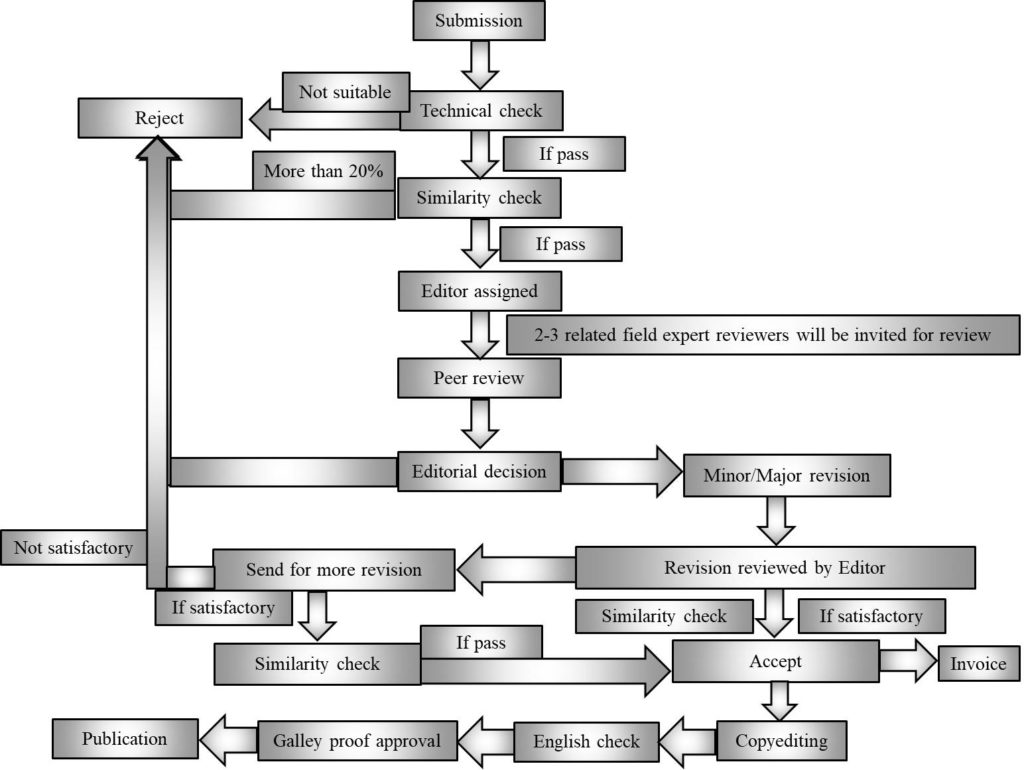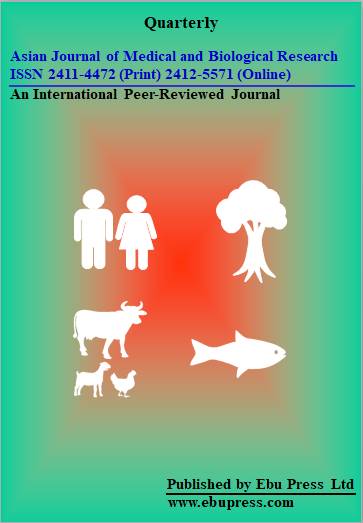About AJMBR
Asian Journal of Medical and Biological Research is an official journal of “Ebu Press Ltd” for sharing and publishing current and advanced knowledge of Medical and Biological Sciences.
Aims & Scope
Asian Journal of Medical and Biological Research is an open access, peer-reviewed, international journal that aims to publish high-quality papers to make them rapidly available to researchers nationwide and worldwide.
Asian Journal of Medical and Biological Research publishes high quality and novelty scientific papers focusing on Medical and Biological Sciences (Medical Science, Dental Science, Veterinary Science, Animal Husbandry, Agriculture, Environmental Science, Fisheries, Food Science and Nutrition, Zoology, Plant Science and Botany, Marine Biology and Marine Science, Pharmaceutical Science, Genetic Engineering and Biotechnology, Microbiology, Public Health, Biochemistry, Cellular and Molecular Life Sciences and so on).
Types of Articles
- Review articles
- Full length research articles
- Short communications
Digital Preservation
Asian Journal of Medical and Biological Research is registered in Sherpa Romeo, which is an online resource that aggregates and presents publisher and journal open access policies from around the world. The articles in Asian Journal of Medical and Biological Research are deposited as Crossref metadata which are preserved by the CLOCKSS (Controlled Lots of Copies Keep Stuff Safe) system.
Editorial Process
The AJMBR is committed to upholding the highest standards of content quality and ethical integrity through a meticulous editorial process. The journal adheres to a well-defined editorial workflow, as illustrated in the accompanying flow chart, to ensure these standards are met.

The editorial process for the AJMBR typically involves the following stages-
Submission of the manuscript: The process begins when authors submit their research manuscripts to AJMBR for potential publication. Authors are required to follow the journal’s submission guidelines, which typically include manuscript structure, reference format, and file type.
Technical check: Upon manuscript submission, it undergoes a technical check. This step ensures that the manuscript complies with AJMBR’s specific formatting and submission requirements. It includes evaluating the manuscript’s structure, adherence to reference formatting, and compatibility with the required file format.
Similarity check: To maintain academic integrity and ethical publishing standards, a similarity check is performed on the submitted manuscript. Specialized software, such as iThenticate/Turnitin, may be employed to identify any instances of plagiarism or excessive similarity to previously published works.
Editor assigned: Once the manuscript passes the initial checks, it is assigned to an editor with expertise in the relevant field. The editor’s role is to oversee the review process, facilitate communication between authors and reviewers, and make editorial decisions based on peer review feedback.
Peer review: The assigned editor selects peer reviewers who are experts in the field of submitted manuscript. These reviewers evaluate the manuscript’s quality, methodology, significance, and validity. They provide detailed comments and recommendations to the editor (for more details, please refer to the review policy).
Editorial decision: Following the peer review process, the editor makes a decision regarding the manuscript. This decision can result in several outcomes:
- Acceptance: If the manuscript is deemed suitable for publication without further revisions, it is accepted.
- Minor revision: Authors are asked to make minor changes or revisions to address specific issues or suggestions from peer reviewers.
- Major revision: Authors are required to make significant changes, which may involve conducting additional experiments or analyses to strengthen the manuscript.
- Rejection: Manuscripts that do not meet the journal’s quality standards or the recommendations of peer reviewers may be rejected.
Minor/major revision: If revisions are requested, authors receive feedback and guidance from peer reviewers and the editor. Authors are expected to address these comments and suggestions in their revised manuscript.
Revision reviewed by editor: After authors make revisions, the editor reviews the revised manuscript to ensure that all suggested changes have been adequately addressed. The editor plays a pivotal role in the final decision-making process.
Rejection after revision: Manuscripts that fail to meet the journal’s quality standards or do not adequately address the reviewers’ concerns may be rejected at this stage.
Send for more revision: If the revisions remain incomplete or unsatisfactory, authors may be asked to make further revisions until the manuscript aligns with the journal’s standards and reviewers’ expectations.
Similarity check for revised manuscript: To verify that any potential issues of plagiarism or excessive similarity have been resolved in the revised manuscript, a similarity check may be repeated.
Accepted: Once the manuscript fully aligns with the journal’s standards and the editor’s satisfaction, it is formally accepted for publication, pending the completion of subsequent steps.
Author invoice: Authors may receive an invoice for publication fees, depending on the journal’s policies. These fees can vary and may cover various publication costs.
Copyediting: The manuscript undergoes a copyediting process to rectify language, grammar, style, and formatting issues. This step ensures that the manuscript is clear, consistent, and adheres to AJMBR’s editorial standards.
English editing: In cases where English is not the author’s native language, additional English editing may be performed to enhance the manuscript’s readability and overall quality.
Galley proof approval: Authors receive a formatted version of the manuscript, often referred to as “galley proof.” They review and approve this final version to check for any remaining errors or issues before publication. This step is crucial to ensure the manuscript’s accuracy and readiness for publication.
Publication: Upon final approval, the manuscript is officially published in AJMBR. It becomes accessible to the scientific community and readers. A DOI (Digital Object Identifier) is typically assigned for reference purposes, and the manuscript is archived within the journal, making it part of its scholarly record.
Membership
Asian Journal of Medical and Biological Research is a member of the Committee on Publication Ethics (COPE).



